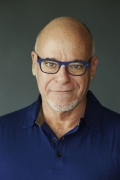
Bernard Cooper, 1991 PEN/Hemingway Award Winner for Maps to Anywhere
Q: Maps to Anywhereis comprised of fragments, prose poems, and essays about your father, your brother’s death, art, and objects such as a barber’s pole. What inspired you to write the book?
A: I didn’t think of Maps to Anywhere as a book until I’d written enough pieces to notice the interconnections and echoes among those pieces. My initial impulse was to write prose poems, which I loved for their compression. Short prose pieces accommodated my restless imagination and allowed me to adopt a spirit of experimentation. I wasn’t sure what genre the work might comfortably fit within, but how these pieces would eventually be defined was far less interesting to me than writing in the way I wanted (as if I could write in any other way!) regardless of how the results would be categorized. The nature of the prose poem itself contains aspects of fiction, nonfiction, and poetry, and I was interested in hybridizing these forms as each particular subject demanded.
Q: Were you surprised that Maps to Anywherereceived critical acclaim?
A: Yes. Maps to Anywhereseemed like an eccentric book, and although I possessed a deep admiration for non-conforming artists and oddball forms of art and literature, I wasn’t expecting what might be termed “mainstream success,” if in fact that’s what this book achieved.
Q: You are also an award-winning artist and former art critic. How do the mediums of art and writing (prose or poetry) differ?
A: Flannery O’Connor said that sight was the writer’s most important sense, and in writing, I was attempting to give language the tangibility of actual sensory experience. In visual art, I rely on the kind of editing and continual refining that writing requires. There are differences between writing and visual art, of course, but in each, one is shaping her material in order to make it seductive and vivid and meaningful to someone else. My work has always been informed and inspired by art outside of the art form I happen to be working in at the moment.
Q: You received your BFA and MFA from California Institute of the Arts. Do you believe your degree prepared you for your career as a writer? How?
A: It reinforced my commitment to experimentation and to the rigors and challenges of a life devoted to making art. Cal Arts taught me how to be relatively self-reliant, to follow my instincts, and see projects through to the end.
Q: Do you remember where you were when you received the news about winning the PEN/Hemingway Award?
A: I was at home. I told my partner and then immediately came up with several long, elaborate scenarios in which the news turned out to be a mistake. After listening patiently, he said, “See. You absolutely deserve an award for fiction.”
Q: Do you have a favorite Ernest Hemingway story or book?
A: “For sale: baby shoes, never worn.”
The attribution of this story to Hemingway has never been proven, but I hope he’s the author. It’s a stunning distillation of tragedy and implies a life of unhappy circumstances. I’ve used it in many writing workshops to illustrate concise writing, and to show how a writer can point to a world outside the confines of even the shortest narrative.
Q: Are you working on anything new at the moment-art or literature?
A: I’ve been making visual art with a fervor and am currently in a two-person show at The Pacific Design Center in Los Angeles. I recently finished a long essay about insomnia and the drug Ambien, which is also about the death of my partner in 2006.
Q: How can your readers, new readers, or art aficionados stay in touch with you?